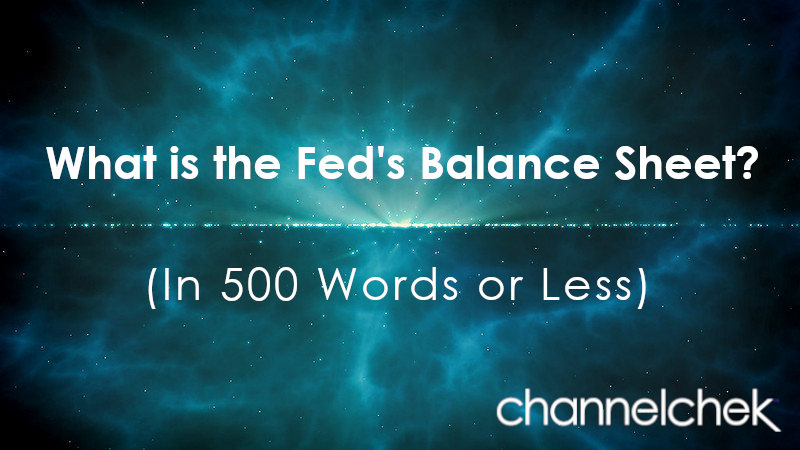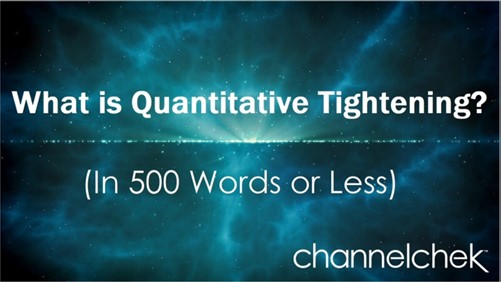Image Credit: Stuart Richards (Flickr)
Is Quantitative Tightening Impacting the Economy on the QT?
The Fed has begun to reduce the trillions it has added to its balance
sheet. With each dollar it added to the economy over the past two years, there was a new dollar available to provide capital for growth and investment. Or a new dollar to help hold borrowing costs down. Quantitative
tightening (QT) is out of the spotlight relative to overnight bank lending rates. Yet, QT could have a much greater economic impact on all markets, from real estate to stocks, and more directly fixed income.
There is less understanding of QT. The Federal Reserve’s effort to shrink its balance sheet after buying trillions in bonds is somewhat complicated and less visible. But, although QT is on the quieter side of what is shaping tomorrow’s economy, investors need to know how shrinking the balance sheet, the other tightening, impacts investments.
The Fed stopped its bond purchases in May. That is to say, they stopped buying bonds that injected money into the system. This is referred to as quantitative easing (QE).
In June, after a period of tapering its purchases, the central bank began QT> Then it announced it would partially unwind roughly $4.5 trillion that had previously been purchased. The Fed officially said that it would start by letting up to $30 billion in US treasuries and $17.5 billion in mortgage-backed securities (MBS) mature out of its holdings (balance sheet). During the previous months, it would have reinvested the maturing amount and even added to the purchases. The announcement was, beginning in September, it’s shrinking the balance sheet could increase to $60 billion maturing bonds not rolled in treasuries and 35 billion not reinvested in MBS securities. Fed Chairman Jerome Powell shared a plan lasting 2½ years, which implies the Fed’s $9 trillion balance sheet could shrink by as much as $2.5 trillion. Roughly half of what was added to support the economy during the pandemic.
Lack of Awareness
The financial news likes to keep it simple. And quantitative tightening isn’t simple, so its impact isn’t reported to the extent that an overnight increase, which is easier to understand, is presented. With QT, there is no prior hype asking “what is the Fed going to do?” and there is little certainty to what they have done. It just happens, no fanfare, no commentary.
Historically, this kind of tightening has been attempted only once before, and it was derailed. The transparent Fed is ridiculed and criticized when it removes economic stimulus. So there may not be a strong overall belief that the Fed will actually remove the trillions of extra money now floating around and creating economic opportunity by inflating asset prices. Also, overnight rate increases are much easier for economists to model and news for mass public consumption to report on.
So, the news of QT is underreported and ignored. What is being reported is a strong doubt that the Fed is following through on its balance-sheet tightening plan, particularly with MBS. For those that have looked at the Federal Reserve’s balance sheet, the doubt is not without cause.
Barron’s spoke with a senior trader on the Fed’s open markets desk. This is what the well-respected investment publication was told. The Fed is conducting QT as it has said it would. The trader said people are confused because it looks like the Fed’s MBS holdings aren’t decreasing and even may be increasing.
The trader told Barrons that the saw-toothed pattern in the Fed’s MBS holdings is the result of accounting issues. First, there is a gap between when MBS purchases settle and when holders of MBS receive payments. Second, the Fed has a three-month window for settling MBS purchases. The Fed is the largest single investor in the MBS market, the Fed has the option of delaying settlements if it thinks that will create a better functioning market.
In effect, this means MBS purchased by the Fed, as it does when it reinvests pay downs, could just be showing up. QE ended, but if there are pay downs in excess of the Feds goal of runoff, the excess is reinvested. The settlement dates differ and cause the appearance of a balance sheet that may have grown. This isn’t the case, and investors need to know that longer-term interest rates are being tightened.
The Fed senior trader warned something is apt to break, not unlike what happened the last time the Fed tried QT, and chaos in the repo market prompted an early end to the return to “normalcy.” But he was more optimistic as he said the Treasury may be more supportive in smoothing the process of reducing liquidity while not disrupting markets.
Take Away
If quantitative easing (QE) mattered, then quantitative tightening should too. It isn’t reported on as prominently as direct interest rate hikes, but the impact is the direct inverse to what allowed so much economic growth. So, the savvy investor will pay attention, which may give them an edge. For the Fed to bring inflation back to 2%, the Federal Reserve would need to shrink its balance sheet by the almost $4 to $5 trillion it increased it a short time ago. This could increase longer-term interest rates by far more than the announced increases in short-term rates.
Managing Editor, Channelchek
Suggested Content
 Powell’s Economic Soft Landing Requires More Room to Change his Mind
|
 Bond Market Understanding is Again Critical for Stock Investors
|
 What is the Fed’s Balance Sheet
|
 What is Quantitative Tightening
|
Sources
https://www.federalreserve.gov/monetarypolicy/bst_recenttrends.htm
https://www.barrons.com/articles/intel-chip-stocks-to-buy-now-51660333062
https://en.wikipedia.org/wiki/Quantitative_tightening
Stay up to date. Follow us:

|
